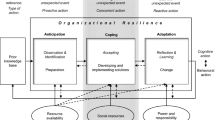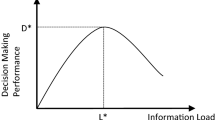Abstract
Coping with complexity is at the heart of management and leadership in the turbulent environments faced by the organizations and societies of our day. The systems approach provides transdisciplinary theories and tools for dealing with this challenge more effectively than efforts merely based on disciplinary insights or pragmatic recipes. In this paper, a concept of "intelligent organizations" is introduced. A framework for the design of intelligent organizations is proposed that links three organizational cybernetic models: the Model for Systemic Control, the Viable System Model, and the Team Syntegrity model.2 The proposition is that a combined use of these models, guided by the integrative conceptual framework, enables a more effective response to complex situations than merely pragmatic approaches to "integrative management." Provisional empirical evidence gathered from applied research indicates that the proposed framework is capable of enhancing such superior potential for effective response. As such, it promises to meet the specific needs of the new types of organizations that have already begun to emerge in the knowledge societies.
Similar content being viewed by others
References
Ackoff, R. L. (1981). Creating the Corporate Future, John Wiley and Sons, New York.
Ackoff, R. L. (1994). The Democratic Corporation, Oxford Unviersity Press, New York/Oxford.
Anderson, R. C. (1998). Mid-course Correction. Toward a Sustainable Enterprise: The Interface Model, Chelsea Green Publishing, White River Junction, VT.
Argyris, Ch. and Schön, D. A. (1978). Organizational Learning: A Theory of Action Perspective, Reading, Mass., Addison-Wesley.
Ashby, W. R. (1956). An Introduction to Cybernetics, Chapman & Hall, London.
Ashby, W. R. (1965). Design for a Brain, Chapman & Hall, London.
Ashby, W. (1981). Analysis of the system to be modeled. In Conant, R., (ed.), Mechanisms of Intelligence. Ross Ashby's Writings on Cybernetics, Intersystems Publications, Seaside, CA, pp. 335–355.
Bavelas, A. (1952). Communication patterns in problem groups. In Cybernetics: Transactions of the Eighth Conference, New York: Josiah Macy Jr. Foundation.
Beer, S. (1962). Towards the cybernetic factory. Reprinted in: Harnden, R. and Leonard, A., (eds.), (1994). How Many Grapes Went into the Wine. Stafford Beer on the Art and Science of Holistic Management, John Wiley and Sons, Chichester.
Beer, S. (1979). The Heart of Enterprise, John Wiley and Sons, Chichester.
Beer, S. (1981). Brain of the Firm, 2nd edition, John Wiley and Sons, Chichester.
Beer, S. (1985). Diagnosing the System for Organizations, John Wiley and Sons, Chichester.
Beer, S. (1989). National Government: Disseminated Regulation in Real Time, or ‘How to Run a Country’. In Espejo, R. and Harnden, R., (eds.), The Viable System Model: Interpretations and Applications of Stafford Beer's VSM, John Wiley and Sons, Chichester, pp. 333–360.
Beer, S. (1994). Beyond Dispute. The Invention of Team Syntegrity, John Wiley and Sons, Chichester.
Bleicher, K. (1996). Das Konzept. Integriertes Management, 4th edition, Campus, Frankfurt/New York (first edition 1991).
Carlzon, Jan (1987). Moments of Truth, Ballinger, Cambridge, Mass.
Conant, R. C., and Ashby, W. R. (1981). Every good regulator of a system must be a model of that system. In Conant, R. (ed.), Mechanisms of Intelligence. Ashby's Writings on Cybernetics, Intersystems Publications, Seaside, CA., pp. 205–214.
Deal, T. E., and Kennedy, A. A. (1982). Corporate Cultures. The Rites and Rituals of Corporate Life, Addison-Wesley, Reading, Mass.
Dorner, D. (1997). The Logic of Failure: Recognizing and Avoiding Error in Complex Situations, Addison-Wesley, Reading, Mass.
Drucker, Peter F. (1977). Management: Tasks, Responsibilities, Practices, Harper's College Press, New York.
Drucker, P. F. (1980). Managing in Turbulent Times, Heinemann, London.
Drucker, P. F. (1999). Drucker on financial services. Innovate or die. The Economist, September 25th, pp. 27–34.
Ellis, J., (1999). Customers desert to digital market. International Herald Tribune, April 1, p. 6.
Espejo, R. (1989). The Viable system model revisited. In Espejo, R. and Harnden, R. (eds.), theViable System Model: Interpretations and Applications of Stafford Beer's VSM, John Wiley and Sons, Chichester, pp. 77–100.
Espejo, R., and Harnden, R., eds. (1989). The Viable System Model. Interpretations and Applications of Stafford Beer's VSM, John Wiley and Sons, Chichester.
Espejo, R., Schuhmann, W., Schwaninger, M., and Bilello, U. (1996). Organizational Transformation and Learning. A Cybernetic Approach to Management, John Wiley and Sons, Chichester.
Espejo, R., and Schwaninger, M., eds. (1993). Organizational Fitness—Corporate Effectiveness through Management Cybernetics, Campus Frankfurt/New York.
Espejo, R., and Schwaninger, M., eds. (1998). To Be and Not to Be, That is the System. A Tribute to Stafford Beer, CD-ROM, Carl-Auer-Systeme-Verlag, Wiesbaden.
Espejo, R., and Watt, J. (1988). Information management, organization and managerial effectiveness. J Oper Res Soc, 39, 7–14.
Etzioni, A. (1968). The Active Society. A Theory of Societal and Political Processes, Collier, MacMillan, London/New York.
Forrester, J. W. (1985). Industrial Dynamics, MIT Press, Cambridge, Mass., 11th printing (originally published 1961).
Fuller, R., Buckminster, X. X., and Applewhite, E. J. (1982). Synergetics: Explorations in the Geometry of Thinking, Macmillan/Collier, New York/London.
Gälweiler, A. (1990). Strategische Unternehmensführung, 2nd edition, Campus, Frankfurt/New York.
Gregory, R. L., ed. (1987). The Oxford Companion to the Mind, Oxford University Press, Oxford/New York.
Jalali, A. (1994). Reverberating networks. Modelling information propagation in syntegration by spectral analysis. In Beer, S. (ed.), Beyond Dispute. The Invention of Team Syntegrity, John Wiley and Sons, Chichester, pp. 263–281.
Jantsch, E., and Waddington, C. H., (eds.) (1976). Evolution and Consciousness: Human Systems in Transition Addison-Wesley, Reading, Mass.
Kim, W. Ch./Mauborgne, R. (1999). Creating new market space. Harvard Business Review, January-February, Vol. 77, Issue 1.
Kotter, J. /Heskett, J. (1992). Corporate Culture and Performance, Free Press, New York.
Krieg, W. (1985). Management-und Unternehmungsentwicklung-Bausteine eines integrierten Ansatzes. In Siegwart, H., Probst, xx, and Gilbert J. B. (eds.), Integriertes Management, Haupt, Bern/Stuttgart, pp. 261–277.
Leonard, A. (1989). Application of the VSM to commercial broadcasting in the United States. In Espejo, R. and Harnden, R., (eds.), The Viable System Model, John Wiley and Sons, Chichester, pp. 176–209.
Leonard, A. (1994). Team syntegrity: Planning for action in the next century. In Brady, B. and Peeno, L., (eds.), Proceedings, Conference of the International Society for the Systems Sciences, Louisville, Kentucky, pp. 1065–1072.
Mingers, J. and Gill, A. eds. (1997). Multimethodology. The Theory and Practice of Combining Management Science Methodologies, John Wiley and Sons, Chichester.
Mitroff, I. I. (1983). Stakeholders of the Organizational Mind, Jossey Bass, San Francisco.
Nonaka, I. and Takeuchi, H. (1995). The Knowledge-Creating Company, Oxford University Press, Oxford.
Pettigrew, A. M., and Whipp, R. (1993). Managing Change for Competitive Success, Blackwell, Oxford.
Rapoport, A. (1992). Weltbilder—Wissen und Glauben: Die systemische Sicht. In Weltbilder—Wissen und Glauben, Aulavorträge, Nr. 55, St. Gallen, Hochschule St. Gallen, pp. 3–27.
Reither, F. (1997) Komplexitätsmanagement. Denken und Handeln in komplexen Situationen, Gerling Akademie Verlag, Munich.
Rudolph, Th. (1999). Marktorientiertes Management komplexer Projekte im Handel, Schäffer-Poeschel, Stuttgart.
Schein, E. H. (1985). Organizational Culture and Leadership, Jossey-Bass, San Francisco/London.
Schwaninger, M. (1988). Anwendung der integralen Unternehmungsentwicklung. Beurteilung von Konzept und Methodik anhand einer Pilotstudie, Haupt, Bern/Stuttgart.
Schwaninger, M. (1989). Integrale Unternehmungsplanung, Campus, Frankfurt/New York.
Schwaninger, M. (1993). A Concept of Organizational Fitness. In Espejo, R., and Schwaninger, M. (eds.), Organizational Fitness—Corporate Effectiveness through Management Cybernetics, Campus, Frankfurt/New York: Campus, pp. 39–66.
Schwaninger, M. (1995). Enabling Systemic Management, Working Paper, Institute of Management at the University of St. Gallen (published as part of Espejo et al., 1996).
Schwaninger, M. (1996). Structures for Intelligent Organizations, Discussion Paper, Institute of Management, University of St. Gallen, No. 20.
Schwaninger, M. (1997a). Global Transdisciplinary Research Co-operation: Thirty Cyberneticians Online. Kybernetes, 26, pp. 459–463.
Schwaninger, M. (1997b). The dynamics of environmental responsibility in management. In Barlas, Y., Dikat, V. G., and Polat, S., (eds.), 15th International System Dynamics Conference, Proceedings, Bogaziçi University, Istanbul, Turkey.
Schwaninger, M. (1998). Anatol Rapoport, ISSS-International Society for the Systems Sciences, homepage, “luminaries” section—http://www.isss.org/lumrapo.
Schwaninger, M. (1999). Self-organization and self-reference in the cognition of organizations. In Braitenberg, V., and Radermacher, F.-J., (eds.), Interdisciplinary Approaches to a New Understanding of Cognition and Consciousness, Universitaets-Verlag, Ulm.
Schwaninger, M., Hechenblaickner, P., Krafft, A., and Steiner, S. (1995). Research Report on the “Kingview Syntegration,” July 17–20, Toronto, Canada, and St. Gallen, University of St. Gallen.
Senge, P. M. (1992). The Fifth Discipline. The Art and Practice of the Learning Organization, Century Business, London.
Sternberg, R. J. (1987). Intelligence. In Gregory, R. L., (ed.), The Oxford Companion to the Mind, Oxford University Press, Oxford/New York, pp. 375–379.
Ulrich, H. (1984). Management. Campus, Bern/Stuttgart.
Ulrich, H., and Krieg, W. (1972). St. Galler Management-Modell, Haupt, Bern.
Willemsen, M. H. (1992). Die Schweizerische Eidgenossenschaft als lebensfähiges System. Kybernetische Analyse des schweizerischen politischen Systems, Dissertation Nr. 1314, Hochschule St. Gallen, St. Gallen, Switzerland.
Author information
Authors and Affiliations
Rights and permissions
About this article
Cite this article
Schwaninger, M. Managing Complexity—The Path Toward Intelligent Organizations. Systemic Practice and Action Research 13, 207–241 (2000). https://doi.org/10.1023/A:1009546721353
Issue Date:
DOI: https://doi.org/10.1023/A:1009546721353




